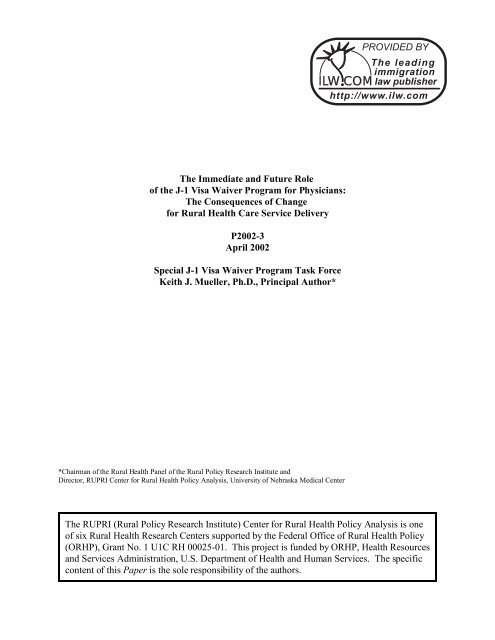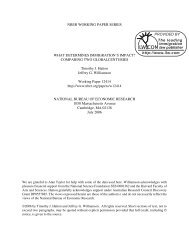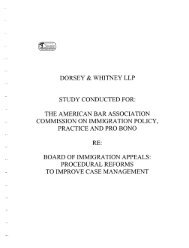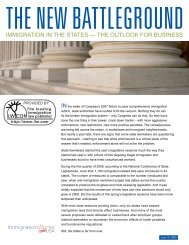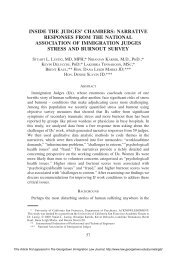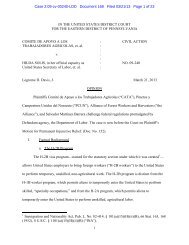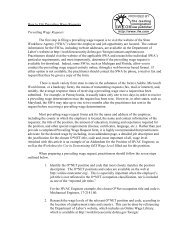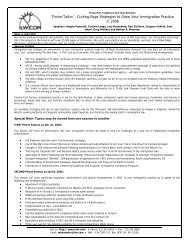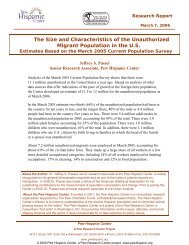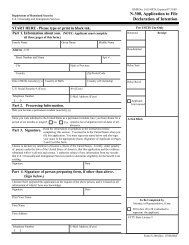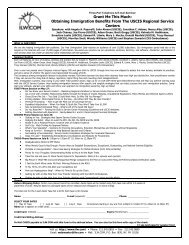The RUPRI (Rural PolicyResearch Institute) Centerfor ... - ILW.com
The RUPRI (Rural PolicyResearch Institute) Centerfor ... - ILW.com
The RUPRI (Rural PolicyResearch Institute) Centerfor ... - ILW.com
You also want an ePaper? Increase the reach of your titles
YUMPU automatically turns print PDFs into web optimized ePapers that Google loves.
<strong>The</strong> Immediate and Future Role<br />
of the J-1 Visa Waiver Program for Physicians:<br />
<strong>The</strong> Consequences of Change<br />
for <strong>Rural</strong> Health Care Service Delivery<br />
P2002-3<br />
April 2002<br />
Special J-1 Visa Waiver Program Task Force<br />
Keith J. Mueller, Ph.D., Principal Author*<br />
*Chairman of the <strong>Rural</strong> Health Panel of the <strong>Rural</strong> Policy Research <strong>Institute</strong> and<br />
Director, <strong>RUPRI</strong> Center for <strong>Rural</strong> Health Policy Analysis, University of Nebraska Medical Center<br />
<strong>The</strong> <strong>RUPRI</strong> (<strong>Rural</strong> Policy Research <strong>Institute</strong>) Center for <strong>Rural</strong> Health Policy Analysis is one<br />
of six <strong>Rural</strong> Health Research Centers supported by the Federal Office of <strong>Rural</strong> Health Policy<br />
(ORHP), Grant No. 1 U1C RH 00025-01. This project is funded by ORHP, Health Resources<br />
and Services Administration, U.S. Department of Health and Human Services. <strong>The</strong> specific<br />
content of this Paper is the sole responsibility of the authors.
Preface<br />
<strong>The</strong> <strong>RUPRI</strong> Center for <strong>Rural</strong> Health Policy Analysis assembled a distinguished group of national<br />
experts in recruiting and placing J-1 visa waiver physicians. <strong>The</strong>se experts contributed directly<br />
to the content of this Paper:<br />
Special J-1 Visa Waiver Program Task Force<br />
Mary Amundson, M.A., University of North Dakota<br />
Andrew F. Coburn, Ph.D., University of Southern Maine*<br />
Charles W. Fluharty, M.Div., <strong>Rural</strong> Policy Research <strong>Institute</strong>*<br />
J. Patrick Hart, Ph.D., University of Nebraska Medical Center*<br />
T. Robert Konrad, M.D., University of North Carolina-Chapel Hill<br />
Suzanne Lavergne, Louisiana State Office of <strong>Rural</strong> Health<br />
Harvey Licht, Primary Care and <strong>Rural</strong> Health Office, New Mexico Department of Health<br />
A. Clinton MacKinney, M.D., M.S., HealthPartners Central Minnesota Clinics*<br />
Timothy D. McBride, Ph.D., University of Missouri-St. Louis*<br />
Stephen S. Mick, Ph.D., Virginia Commonwealth University<br />
Fred Moskol, National <strong>Rural</strong> Recruitment and Retention Network<br />
Howard S. (Sam) Myers, III, Attorney, Myers Thompson P.A.<br />
Wayne Myers, M.D., Myers Consulting<br />
George S. Newman, J.D., Blumenfeld, Kaplan & Sandweiss, P.C.<br />
Robert L. Phillips, M.D., M.S.P.H., American Academy of Family Physicians<br />
Rebecca T. Slifkin, Ph.D., University of North Carolina-Chapel Hill*<br />
Mary K. Wakefield, Ph.D., R.N., University of North Dakota*<br />
Stephen D. Wilhide, M.S.W., M.P.H., National <strong>Rural</strong> Health Association<br />
<strong>The</strong> Task Force thanks the following people<br />
at the <strong>RUPRI</strong> Center for <strong>Rural</strong> Health Policy Analysis<br />
for their contributions to this document:<br />
Dianne Harrop, M.S.<br />
Brandi Shay<br />
Sue Nardie<br />
*Also serves on the <strong>Rural</strong> Health Panel of the <strong>Rural</strong> Policy Research <strong>Institute</strong>
Table of Contents<br />
Purpose .....................................................................1<br />
Impact of the J-1 Visa Waiver Program on <strong>Rural</strong> Underserved Areas .................1<br />
Policy Choices ................................................................3<br />
Participation of Federal Agencies in Requesting J-1 Visa Waivers .................3<br />
Meeting Concerns for Homeland Security .....................................3<br />
Status of the Conrad-20 Program: How Best to Use This State Option ..............4<br />
Alternative Sources of Physicians for <strong>Rural</strong> Underserved Areas ...................5<br />
Re<strong>com</strong>mendations ............................................................7<br />
References ...................................................................8<br />
Appendix ...................................................................10<br />
Recent Health Policy Documents ...............................................12<br />
<strong>RUPRI</strong> Mission, Vision, and 2002 Program of Work ...............................13
PURPOSE<br />
<strong>The</strong> longstanding and well-documented problem of maldistribution of physicians resulting in<br />
areas of shortage continues to plague much of rural America. <strong>The</strong> supply of physicians to those<br />
shortage areas currently includes physicians from nations other than the U.S.—international<br />
medical graduates (IMGs)—who obtain waivers on visa requirements (J-1 visas), allowing them<br />
to remain in the U.S. after their residency training. This Policy Paper addresses the question:<br />
What are the consequences for the<br />
delivery of health care services in<br />
rural underserved areas if current<br />
policies governing the granting of J-1<br />
visa waivers are changed (resulting in<br />
increases or decreases in the numbers<br />
of physicians affected)?<br />
This Policy Paper will provide available<br />
information and analysis to help frame and<br />
examine policy options for placing physicians<br />
in rural underserved areas.<br />
IMPACT OF THE J-1 VISA WAIVER<br />
PROGRAM ON RURAL UNDERSERVED<br />
AREAS<br />
In September 1999, over 2,000 IMGs with J-1<br />
visa waivers were practicing in shortage areas<br />
(urban and rural), as <strong>com</strong>pared to 1,356<br />
physicians in the National Health Service Corps<br />
(NHSC) (U.S. General Accounting Office, 2001).<br />
J-1 visa waiver physicians are currently<br />
providing care to over 4 million people living in<br />
underserved areas of rural America. 5 A recent<br />
analysis of the geographic distribution of IMGs<br />
concluded: “If all IMGs currently in primary care<br />
______________________<br />
PHYSICIANS PLACED IN UNDERSERVED<br />
AREAS, BY TYPE, BY YEAR<br />
J-1 VISA WAIVERS<br />
USDA: 1<br />
1994-1997: 2,317<br />
1998-1999: 542<br />
2000: 165<br />
2001: 74<br />
rural: all but 571 of the 8 year total of 3,098;<br />
most of the 571 occurred in 1994-1997<br />
Conrad-20: 2<br />
1998: 432 - 522<br />
1999: 423 - 513<br />
2000: 459 - 549<br />
2001: 469 - 559<br />
rural: Estimated to be 62% of the total<br />
Appalachian Regional Commission: 3<br />
1998: 100<br />
1999: 92<br />
2000: 58<br />
2001: 64<br />
NATIONAL HEALTH SERVICE CORPS 4<br />
1999: 436<br />
2000: 365<br />
2001: 375<br />
rural: exact number not known, estimated to be<br />
61%, based on percent of all NHSC placements<br />
1 Per USDA program coordinator, March 2002.<br />
2 Data from a survey <strong>com</strong>pleted for the Federal Office of <strong>Rural</strong> Health Policy in April 2002 (37 participating<br />
Conrad-20 states provided data for the number of Conrad-20 physicians practicing as of April 2002). Missing state<br />
data were imputed by using the average number of state-reported Conrad-20 physician waiver re<strong>com</strong>mendations<br />
obtained from: Berry, C., Dopp, A., and Caro-Justin, B. (2001). J-1 visa waivers: Program update and “next steps.”<br />
2001 Primary Care Symposium. Bethesda, MD.<br />
3 Information provided by Appalachian Regional Commission, April 11, 2002.<br />
4 Data obtained from the NHSC by the Federal Office of <strong>Rural</strong> Health Policy, April 2002.<br />
5 This number is based on the median number of persons who are active patients under the care of a primary care<br />
physician (2,363), per data provided by Medical Group Management Association of America.<br />
1
practice were removed from this calculation [of counties with shortages, 30% of all rural<br />
counties], one out of every five ‘adequately served’ nonmetropolitan counties would be<strong>com</strong>e<br />
underserved. In addition, the number of rural counties with no primary care physicians would<br />
rise from 161 to 212" (Baer, Konrad, and Slifkin, 2001, p. 1). In 1996, IMGs (most of whom<br />
would be J-1 visa waiver physicians) represented the following percentages of primary care<br />
physicians in counties classified by shortage status:<br />
• in whole county Health Professional Shortage Areas (HPSAs), 18.7%;<br />
• in partial county HPSAs, 15.2%; and<br />
• in non-HPSA counties, 14.3% (Baer, Ricketts, Konrad, and Mick, 1998).<br />
A study in New York state found that the contribution of IMGs on temporary waivers was not “as<br />
dramatic as was previously thought,” but nonetheless the percent of J-1 visa waiver IMGs<br />
planning to practice in shortage areas was triple that of U.S. medical graduates (USMGs)<br />
(Salsberg and Nolan, 2000). IMGs fill various safety net needs at a rate disproportionately higher<br />
than that for USMGs, including in areas with high infant mortality rates, low socioeconomic<br />
status, high non-white population, and states with high rural population percentages (Mick, Lee,<br />
and Wodchis, 2000).<br />
IMGs are more likely to serve African-American and Hispanic patients and to practice in public<br />
settings (Blanco, Carvalho, Olfson, Finnerty, and Pincus, 1999). <strong>The</strong>y are also more likely than<br />
USMGs to begin their pediatric practices in rural HPSAs (Randolph and Pathman, 2001). <strong>The</strong><br />
same is true for general internists; IMGs are more than twice as likely to practice in rural<br />
underserved areas (Phillips, Fryer, and Fink, 2001). Finally, “new IMGs tend to locate in<br />
markets in which a large proportion of the population is of their own race/ethnicity” (Polsky,<br />
Kletke, Wozniak, and Escarce, 2000).<br />
<strong>The</strong>se impacts on rural underserved areas are clear from the evidence presented in the literature:<br />
• IMGs are helping to fill a need for primary care physicians;<br />
• IMGs are filling specific needs in pediatrics and general internal medicine; and<br />
• IMGs are a resource for meeting the needs of new immigrant populations.<br />
More information would be helpful to determine more detail about the impact of IMGs:<br />
• locations of the patients seen by IMGs (urban or rural, in or out of shortage areas);<br />
• precise placements of J-1 visa waiver physicians, by classification of county on<br />
the urban-rural continuum (or other measure of rurality);<br />
• updated information on where IMGs practice after <strong>com</strong>pleting the J-1 visa waiver<br />
<strong>com</strong>mitment; and<br />
• patient mix seen by J-1 visa waiver physicians, including how many physicians<br />
not in Federally Qualified Health Centers accept sliding fee schedule payments,<br />
and the percent of Medicaid and uninsured patients cared for.<br />
2
POLICY CHOICES<br />
Participation of Federal Agencies in Requesting J-1 Visa Waivers<br />
A description of the involvement of federal agencies, since 1998, can be found in the Appendix<br />
and in the data box on page one of this Paper. As of February 27, 2002, the USDA no longer<br />
requests placements for physicians seeking waivers from the J-1 visa requirement to return to<br />
their homeland. <strong>The</strong> USDA’s decision was based on not having the staff to make sure security<br />
considerations were resolved (the USDA press secretary quoted in Dvorak, 2002). This decision<br />
has a disproportionate impact on some states that have a high number of physicians placed<br />
through the USDA process, which in 1994-2001 were: Texas (449), Louisiana (250), Michigan<br />
(242), California (232), and Florida (224). Other states, with smaller total numbers, saw most of<br />
their J-1 placements done through this process, including Kansas, Arkansas, and South Dakota.<br />
<strong>The</strong> total number of placements by the USDA, though, had already been falling each year. That<br />
decline followed a decision to limit any particular site to two placements, and coincided with<br />
increased participation by states in the Conrad-20 program. <strong>The</strong> impact of the USDA decision is<br />
to remove one of several federal agency options that addressed the specific needs in rural<br />
areas in several states.<br />
Meeting Concerns for Homeland Security<br />
<strong>The</strong> nation’s renewed interest in evaluating the security risk of all immigrants has affected the J-1<br />
Visa Waiver Program, even though physicians re<strong>com</strong>mended for that status have already been<br />
screened for entry into the U.S. when they obtained their visas. Physicians re<strong>com</strong>mended for<br />
waivers during the next several years will have undergone security clearance for visa purposes<br />
prior to the events of September 11, 2001. Security screening procedures have changed since<br />
that time, including identification of nations of origin that trigger special security reviews. For<br />
any temporary resident undergoing a change in status a new security check may be appropriate.<br />
<strong>The</strong>re are reasons, however, to treat waivers for J-1 visa physicians differently:<br />
• the physicians have already been in the U.S. for at least three years without<br />
manifestations of security risk;<br />
• the ethical code of physicians would make them less likely to be terrorist threats;<br />
and<br />
• the re<strong>com</strong>mendations for waivers would have them remaining in the U.S. for the<br />
explicit purpose of serving residents of underserved <strong>com</strong>munities.<br />
Given the legal requirement that J-1 visa waiver physicians provide services in areas of great<br />
need, based upon a request by providers or governments in those areas, terminating the program,<br />
or requiring that all security checks be <strong>com</strong>plete before a waiver can be granted, could adversely<br />
affect the health of residents in those areas. <strong>The</strong>refore, a balance is required between security<br />
interests and the needs of underserved <strong>com</strong>munities for which the only provision of primary<br />
health care will <strong>com</strong>e from J-1 visa waiver physicians. For example, a presumption of non-risk<br />
could be used to allow placement in underserved areas, subject to revocation should an ongoing<br />
3
investigation reveal a risk to national security. This would mean that physicians requesting<br />
waivers are subject to the same security clearance procedures, <strong>com</strong>pleted by the same agency, as<br />
any other foreign national changing visa status, but that the priority domestic need—providing<br />
health care services—would not go unmet while a security check is <strong>com</strong>pleted.<br />
Once the question of how to be sure homeland security is protected while meeting the needs of<br />
underserved <strong>com</strong>munities is resolved, the USDA may want to reconsider its decision to withdraw<br />
from the program. If not, other agencies could consider be<strong>com</strong>ing more active in the J-1 Visa<br />
Waiver Program. Specifically, the Department of Health and Human Services is currently<br />
participating only to request waivers for physicians involved in research (per regulations<br />
published in 1984, 49 Federal Register 9900, March 16, 1984), and could fill the void left by the<br />
USDA. Another option would be for other regional <strong>com</strong>missions, in addition to the Appalachian<br />
Regional Commission (ARC), to participate in the program (such as the Mississippi Delta<br />
Commission). Increased involvement by federal agencies other than the USDA would help<br />
secure placements in those states not wanting to participate in the Conrad-20 state program, and<br />
those states in which the limit on how many waivers can be requested is below their need.<br />
Status of the Conrad-20 Program: How Best to Use This State Option<br />
As of March 25, 2002, 44 states participate in the Conrad-20 program, placing physicians in<br />
either HPSAs or Medically Underserved Areas (MUAs) (Berry, Dopp, and Caro-Justin, 2001,<br />
with states updated to include California and Arkansas). Approximately 62% of those physicians<br />
are placed in rural settings. 6 Of states who currently place 20 or almost 20 physicians per year<br />
through this program, 21 said they could place more than 20 if the limit were not in place (Berry,<br />
Dopp, and Caro-Justin, 2001). Although experience with the program varies considerably across<br />
the states, some general points can be made:<br />
• most states coordinate placement through the Conrad-20 program with other<br />
waiver placement efforts such as the USDA and ARC and with NHSC<br />
placements;<br />
• the Conrad-20 program allows for targeting sites not included in other waiver<br />
programs or in the NHSC placements;<br />
• staff time required to administer the program is minimal—less than one full time<br />
equivalent in almost all participating states;<br />
• most states require that sites where J-1 visa waiver physicians will practice accept<br />
Medicaid, Medicare, and the uninsured;<br />
• all but five states track the placements, with only 69 violations of J-1 requirements<br />
found in a five-year period (Berry, Dopp, and Caro-Justin, 2001); and<br />
• because physicians admitted under the J-1 Visa Waiver Program (unlike those in<br />
the NHSC) are not required to be primary care physicians, the flexibility of the<br />
6 Data from a survey <strong>com</strong>pleted for the Federal Office of <strong>Rural</strong> Health Policy in April 2002 (37 participating<br />
Conrad-20 states provided data for the number of Conrad-20 physicians practicing as of April 2002).<br />
4
option is particularly attractive to rural hospitals requiring physicians in critical<br />
specialities, such as general surgery, radiology, and anesthesiology, which are<br />
required to sustain <strong>com</strong>munity hospitals serving HPSAs and MUAs.<br />
During the past few years, advocates of this program have suggested it be expanded to a limit of<br />
40 placements per state per year. That proposal has been incorporated into legislation introduced<br />
in 2001 by Senator Brownback (with Senators Graham and Helms), the <strong>Rural</strong> and Urban Health<br />
Care Act of 2001 (S. 1259).<br />
Alternative Sources of Physicians for <strong>Rural</strong> Underserved Areas<br />
Currently, the number of J-1 visa waiver physicians meeting needs in rural HPSAs exceeds the<br />
number of NHSC physicians doing so. <strong>The</strong> President’s fiscal year 2003 budget proposal would<br />
increase the NHSC recruitment budget from $99 million (which was an increase from $84<br />
million the previous year) to $143 million. This budget funds scholarships and loan repayments<br />
for primary care providers and dental and mental health professionals. <strong>The</strong> increased resources<br />
will not close the gap that would exist if positions currently filled by IMGs were vacated. <strong>The</strong>re<br />
are considerations other than total numbers when suggesting the NHSC be a source for replacing<br />
J-1 visa waiver physicians:<br />
• NHSC physicians can only be placed in HPSAs, not in MUAs.<br />
• NHSC placements are used only for primary care physicians.<br />
• <strong>The</strong> supply of NHSC physicians is a highly variable function of the size of<br />
graduating classes from U.S. medical schools, the <strong>com</strong>position of those classes in<br />
terms of their interest in primary care medicine, and the availability of alternative<br />
sources of financing medical school tuition and/or paying off debt incurred during<br />
the course of medical education. <strong>The</strong>se factors will affect the percent of U.S.<br />
graduates making a <strong>com</strong>mitment to the NHSC, and since there is not a history of<br />
expanding the program to meet all needs, the attraction to the program beyond the<br />
current supply is unknown.<br />
• <strong>The</strong> demand for NHSC physicians will increase as the expansion of Community<br />
Health Centers continues, increasing the annual vacancies in those agencies from<br />
700 to 1,100 physicians (estimate provided by the Bureau of Primary Health<br />
Care).<br />
<strong>The</strong> demand for J-1 visa waiver physicians could be reduced by improved retention of physicians<br />
in HPSAs (and MUAs). For example, the supply of physicians in whole-county HPSAs who<br />
were neither NHSC- or J-1-related increased from 5,247 in 1988 to 7,371 in 1998; of those<br />
physicians, 2,782 and 3,841, respectively, were in primary care (family practice, general internal<br />
medicine, and general pediatrics). <strong>The</strong> number of J-1 visa waiver physicians in those areas was<br />
414 in 1988 and 285 in 1998 (Mick, Fisher, and Davis, 2001). For partial county HPSAs, the<br />
number of “other” primary care physicians increased from 13,567 in 1988 to 20,039 in 1998;<br />
<strong>com</strong>parable numbers for J-1 visa waiver physicians were 520 and 623 (Mick, Fisher, and Davis,<br />
2001), which means that the total number of J-1 waiver physicians serving in shortage areas has<br />
5
increased even as the total number of physicians has increased.<br />
Generating a sufficient supply of non-J-1 visa waiver physicians to replace those in practice, if<br />
set as a policy goal, will require attracting a significant percentage of USMGs and USIMGs<br />
<strong>com</strong>pleting residencies who are not already <strong>com</strong>mitted to practice in underserved areas. To<br />
illustrate, in 2000 there were 6,255 primary care residents who graduated from U.S. medical<br />
schools. 7 To replace the approximately 727 J-1 physicians receiving waivers to practice in<br />
underserved areas would have required that 1/6 of all USMG primary care physicians would<br />
practice in underserved areas, in addition to those already doing so (including the 365 NHSC<br />
physicians).<br />
<strong>The</strong>re are state-based programs that use financial incentives, including scholarships and loan<br />
forgiveness, to attract physicians to shortage areas. In 1996, there were 82 programs in 41 states,<br />
with an estimated 1,306 physicians and 370 mid-level providers participating (Pathman et al.,<br />
2000). Medical schools and residency programs can implement programs to develop a work<br />
force more likely to practice in rural locations, including shortage areas.<br />
<strong>The</strong> following strategies should be used to increase the general supply of physicians practicing in<br />
underserved areas:<br />
• Significantly increase physician placements supported by the NHSC.<br />
• Increase support for federal and state programs that increase the number of physicians<br />
who practice in rural underserved areas.<br />
• Continue and strengthen programs authorized under Title VII of the Public Health Service<br />
Act.<br />
• State governments should expand their activities in scholarships, loan repayment, and<br />
other financial incentives to attract physicians to underserved areas.<br />
• State governments should encourage and support training programs in undergraduate<br />
medical curricula and residency programs that are designed to recruit students from rural<br />
areas, train them in rural areas, and secure their initial placement in underserved rural<br />
areas.<br />
7 National Resident Matching Program. Positions offered and filled by U.S. seniors and total applicants<br />
from 1999 through 2001. Received 3/22/02 from http://www.nrmp.org/res_match/table5.htm<br />
6
RECOMMENDATIONS<br />
1. Federal agencies should continue to participate in the J-1 Visa Waiver Program. This<br />
should include consideration by the Department of Health and Human Services to expand<br />
its J-1 visa waiver activities to include re<strong>com</strong>mending waivers for physicians to practice<br />
in underserved areas. If multiple agencies are involved in re<strong>com</strong>mending waivers in the<br />
same geographic area, coordination of effort should be assured, whether through the<br />
auspices of a federal agency, a national contract, or state governments.<br />
2. Homeland security issues involving physicians immigrating to the U.S. for residency<br />
training, and staying in the U.S. under the authority of a J-1 visa waiver, should be<br />
handled the same as for any other foreign national in the same status. Physicians<br />
currently in residency should be required to request a security clearance at the same time<br />
they request a waiver. Physicians re<strong>com</strong>mended for waivers should be allowed to begin<br />
their practice in the underserved area at the time requested by the re<strong>com</strong>mending agency.<br />
<strong>The</strong> waiver would be revoked should any clearance process determine that a physician is<br />
a security risk.<br />
3. <strong>The</strong> Conrad-20 program should be continued, with the current limit of 20 per state per<br />
year expanded to 40 per state per year.<br />
4. State Offices of <strong>Rural</strong> Health should be encouraged to participate in the process of<br />
re<strong>com</strong>mending waivers for J-1 visa physicians, particularly in reviewing and approving<br />
sites for placement. <strong>The</strong> 3R Net Program could be used to manage <strong>com</strong>munication<br />
between state programs and potential J-1visa waiver physicians.<br />
5. Develop a national management information system to monitor placement of all<br />
federally-obligated physicians including J-1 visa waiver physicians and NHSC<br />
practitioners obligated under federal and joint state-federal scholarship and loan<br />
repayment programs. Appropriate data should include their location during the period of<br />
their service obligation and their practice location upon <strong>com</strong>pletion of that <strong>com</strong>mitment.<br />
7
REFERENCES<br />
Baer, L. D., Ricketts, T. C., Konrad, T. R. & Mick, S. S. (1998). Do international medical<br />
graduates reduce rural physician shortages? Medical Care, 36(11), 1534-1544.<br />
Baer, L. D., Konrad, T. R., & Slifkin, R. T. (2001). If fewer international medical graduates<br />
were allowed in the U.S., who might replace them in rural areas? (Working Paper No.<br />
71). Chapel Hill, NC: North Carolina <strong>Rural</strong> Health Research and Policy Analysis Center,<br />
Cecil G. Sheps Center for Health Services Research, University of North Carolina.<br />
Berry, C., Dopp, A., & Caro-Justin, B. (2001). J-1 visa waivers: Program update and “next<br />
steps.” 2001 Primary Care Symposium. Bethesda, MD.<br />
Blanco, C., Carvalho, C., Olfson, M., Finnerty, M., & Pincus, H. A. (1999). Practice patterns of<br />
international and U.S. medical graduate psychiatrists. American Journal of Psychiatry,<br />
156(3), 445-450.<br />
Dvorak, J. A. (2002, March 25). Terrorism concerns undo program to place doctors in<br />
underserved areas. <strong>The</strong> Kansas City Star. Accessed March 29, 2002, at<br />
www.kansascity.<strong>com</strong>/mld/kansascity/2002/03/25/news/2928540.htm<br />
Mick, S. S., Fisher, R., & Davis, T. (2001). An analysis of the distribution of the physician (MD)<br />
workforce in health profession shortage areas (HPSAs) <strong>com</strong>paring the aggregate<br />
workforce, J-1 visa waiver international medical graduates (IMGs), and National Health<br />
Service Corps (NHSC) workforce, 1988 and 1998. Final Report to the Bureau of Primary<br />
Health Care, Health Resources and Services Administration, U.S. Public Health Service,<br />
U.S. Department of Health & Human Services.<br />
Mick, S. S., Lee, S.-Y. D., & Wodchis, W. P. (2000). Variations in geographical distribution of<br />
foreign and domestically trained physicians in the United States: ‘Safety nets’ or ‘surplus<br />
exacerbation’? Social Science & Medicine, 50, 185-202.<br />
Pathman, D. E., Taylor, D. H., Konrad, T. R., King, T. S., Harris, T., Henderson, T. M.,<br />
Bernstein, J. D., Tucker, T., Crook, K. D., Spaulding, C., & Koch, G. G. (2000). State<br />
scholarship loan forgiveness, and related programs: <strong>The</strong> unheralded safety net. Journal of<br />
the American Medical Association, 284(16), 2084-2092.<br />
Phillips, R. L., Fryer, G. E., & Fink, K. S. (2001, June). International medical graduates and<br />
rural primary care. Poster session presented at the annual meeting of the Academy for<br />
Health Services Research and Health Policy.<br />
8
Polsky, D., Kletke, P. R., Wozniak, G. D., & Escarce, J. J. (2000). Location patterns of new<br />
international medical graduates. Health Services Research Meetings (Meeting Abstracts<br />
at gateway.nlm.nih.gov/gw/Cmd?GMResults).<br />
Randolph, G. D., & Pathman, D. E. (2001). Trends in the rural-urban distribution of general<br />
pediatricians. Pediatrics, 107(2). url:<br />
http://www.pediatrics.org/cgi/content/full/107/2/e18.<br />
Salsberg, E., & Nolan, J. (2000). <strong>The</strong> posttraining plans of international medical graduates and<br />
U.S. medical graduates in New York State. Journal of the American Medical Association,<br />
283 (13), 1749-1750.<br />
U.S. General Accounting Office. (2001). Health Workforce: Ensuring Adequate Supply and<br />
Distribution Remains Challenging. Testimony before the Sub<strong>com</strong>mittee on Health,<br />
Committee on Energy and Commerce, House of Representatives. August 1.<br />
9
APPENDIX<br />
THE PROGRAM AND ITS RURAL APPLICATION<br />
Foreign-born international medical graduates (IMGs) (henceforth the term IMG will assume<br />
foreign-born) can apply for a J-1 visa to pursue graduate medical education in the U.S. If the<br />
IMG is sponsored by the Educational Commission for Foreign Medical Graduates and has a<br />
contract from a U.S. accredited medical school, affiliated hospital, or other institution, the IMG<br />
is permitted to enter the U.S. and remain until the <strong>com</strong>pletion of her/his graduate medical<br />
education. <strong>The</strong> applying alien must:<br />
• have graduated from a medical school listed in the “World Directory of Medical<br />
Schools” published by the World Health Organization;<br />
• pass parts I and II of the National Board of Medical Examiners;<br />
• have <strong>com</strong>petency in oral and written English;<br />
• be able to adapt to the educational and cultural environment in the training setting;<br />
• have made a <strong>com</strong>mitment to return to the country of nationality or last residence<br />
(Section 212(j), U.S. Immigration and Nationality Act); and<br />
• pass the Clinical Skills Assessment examination administered by the Educational<br />
Commission for Foreign Medical Graduates.<br />
<strong>The</strong> length-of-stay in the U.S. with a J-1 visa is limited to the time needed to train as a resident,<br />
to be no longer than seven years. IMGs will have cleared security procedures to enter the U.S.<br />
and will have been in the U.S. a minimum of three years while <strong>com</strong>pleting their residency<br />
training.<br />
Upon <strong>com</strong>pletion of that training, the IMG is required to return to her or his home country for<br />
two years before seeking a different immigrant status. That requirement can be waived (J-1 visa<br />
waiver) if returning would result in persecution in the home country, create a hardship to a<br />
spouse or dependent child, or if a U.S. government agency or State Department of Public Health<br />
requests the waiver (Section 212(e), Immigration and Nationality Act). Requests are made to the<br />
U.S. Department of State, which makes a re<strong>com</strong>mendation to the Immigration and Naturalization<br />
Service (stated in the statute as the U.S. Attorney General) for final ruling. Section 214(l) states<br />
that the Attorney General shall not grant a waiver unless:<br />
• the government of the country to which the alien is otherwise contractually<br />
obligated to return furnishes a written statement that it has no objection to the<br />
waiver;<br />
• the alien demonstrates a bona fide offer of full-time employment and agrees to<br />
begin employment in a facility or organization determined by the Attorney<br />
General to be in the public interest;<br />
10
• the alien agrees to begin employment in the facility or organization within 90 days<br />
of receiving the waiver and agrees to continue for a total of not less than three<br />
years; and<br />
• if an alien’s status is changed to a temporary work visa, the alien must agree to<br />
practice medicine for at least three years in the geographic area or areas<br />
designated as health professional shortage areas (except for Veterans Affairs<br />
facilities).<br />
In addition, if the waiver is sought by a designated state agency, a waiver cannot be granted if<br />
that would cause the total number of waivers granted per that agency’s requests in that year to<br />
exceed 20.<br />
Any U.S. government agency can request a waiver for any purpose that agency describes. State<br />
Departments of Health can also request waivers, up to 20 per year. <strong>The</strong> following J-1 Visa<br />
Waiver Programs have been established:<br />
• U.S. Department of Health and Human Services—requests waivers for physicians<br />
who are participating in research projects.<br />
• U.S. Department of Veterans Affairs—requests waivers for physicians who must<br />
be employed at least 50% by a Veterans Affairs facility and be participating in<br />
research, teaching, or patient care.<br />
• U.S. Department of Agriculture—requested waivers for primary care physicians<br />
who will work in (or primarily serve) a rural health professional shortage area not<br />
otherwise “fully served.” <strong>The</strong> state health department must concur with the<br />
waiver. <strong>The</strong> U.S. Department of Agriculture terminated its involvement in<br />
sponsoring foreign research scientists and re<strong>com</strong>mending waivers of the home<br />
residency requirement for foreign physicians, effective February 27, 2002.<br />
• Appalachian Regional Commission—requests waivers for physicians who will<br />
work in a specified shortage area in the Appalachian region and who must practice<br />
primary care or psychiatric care for 40 hours per week for at least three years in a<br />
facility that serves Medicaid, Medicare, and indigent uninsured patients.<br />
• State Departments of Health in 44 states—request waivers for physicians to work<br />
in either health professional shortage areas or medically underserved areas. Many<br />
states limit this to primary care physicians, although that is not a national<br />
requirement.<br />
11
Recent Health Policy Documents<br />
Inequitable Access: Medicare+Choice Program Fails to Serve <strong>Rural</strong> America. February 2002.<br />
(PB2002-2)<br />
Comments on Regulatory and Contractor Reform Legislation. January 2002. (PB2002-1)<br />
Comments on the June 2001 Report of the Medicare Payment Advisory Commission: “Medicare<br />
in <strong>Rural</strong> America.” September 28, 2001. (P2001-14)<br />
Redesigning Medicare : Considerations for <strong>Rural</strong> Beneficiaries and Health Systems. Special<br />
Monograph. May 15, 2001. (SM-1)<br />
Can Payment Policies Attract M+C Plans to <strong>Rural</strong> Areas? May 2001. (PB2001-8)<br />
An Update on Medicare+Choice: <strong>Rural</strong> Medicare Beneficiaries Enrolled in Medicare+Choice<br />
Plans through October 2000. March 2001. (PB2001-7)<br />
Redesigning Medicare: Considerations for <strong>Rural</strong> Beneficiaries and Health Systems. February<br />
2001. (PB2001-6)<br />
<strong>Rural</strong> Implications of the Medicare, Medicaid, and SCHIP Benefits Improvement and Protection<br />
Act of 2000: Concerns, Legislation, and Next Steps. A Companion Brief to P2001-3. January<br />
2001. (PB2001-4)<br />
<strong>Rural</strong> Implications of the Medicare, Medicaid, and SCHIP Benefits Improvement and Protection<br />
Act of 2000: Final Bill: P.L. 106-554. A Consolidation of P2000-16 and PB2001-1. January 15,<br />
2001. (P2001-3)<br />
Designing a Prescription Drug Benefit for <strong>Rural</strong> Medicare Beneficiaries: Principles, Criteria, and<br />
Assessment. A Joint Policy Paper of the Maine <strong>Rural</strong> Health Research Center and the <strong>RUPRI</strong><br />
<strong>Rural</strong> Health Panel. August 31, 2000. (P2000-14)<br />
Redesigning the Medicare Program: An Opportunity to Improve <strong>Rural</strong> Health Care Systems?<br />
August 31, 2000. (P2000-13)<br />
<strong>The</strong> Area Wage Index of <strong>The</strong> Medicare Inpatient Hospital Prospective Payment System:<br />
Perspectives, Policies, and Choices. August 27, 2000. (P2000-12)<br />
Health Insurance in <strong>Rural</strong> America. August 2000. (PB2000-11)<br />
Improving Prescription Drug Coverage for <strong>Rural</strong> Medicare Beneficiaries: Key <strong>Rural</strong><br />
Considerations and Objectives For Legislative Proposals. June 30, 2000. (P2000-8)<br />
12
<strong>RUPRI</strong> Mission<br />
<strong>The</strong> <strong>Rural</strong> Policy Research <strong>Institute</strong> provides objective analysis and facilitates public dialogue<br />
concerning the impacts of public policy on rural people and places.<br />
<strong>RUPRI</strong> Vision Statement<br />
“<strong>The</strong> <strong>Rural</strong> Policy Research <strong>Institute</strong> will be recognized as the premier source of unbiased, policy<br />
relevant analysis and information on the challenges, needs and opportunities facing rural people<br />
and places.”<br />
Additionally, <strong>RUPRI</strong> will be viewed as a national leader and model in demonstrating how an<br />
academic-based enterprise can–<br />
• Build an effective and lasting bridge between science and policy.<br />
• Meet diverse clientele needs in a flexible and timely fashion.<br />
• Foster and reward scientists who wish to contribute to the interplay between<br />
science and policy.<br />
• Over<strong>com</strong>e institutional and geographic barriers.<br />
• Make adjustments in the academic “product mix” to enhance relevancy and<br />
societal contributions.<br />
2002 Program of Work<br />
National Centers<br />
Community Informatics Resource Center<br />
<strong>RUPRI</strong> Center for <strong>Rural</strong> Health Policy<br />
Analysis<br />
Center for Entrepreneurship in <strong>Rural</strong><br />
America<br />
National Work Groups<br />
Community Policy Analysis Network<br />
(CPAN)<br />
Panels<br />
<strong>Rural</strong> Health<br />
<strong>Rural</strong> Policy<br />
<strong>Rural</strong> Welfare Reform<br />
<strong>Rural</strong> Tele<strong>com</strong>munications<br />
Topical Research<br />
<strong>Rural</strong> Tele<strong>com</strong>munications<br />
<strong>Rural</strong> Education<br />
<strong>Rural</strong> Entrepreneurship<br />
<strong>Rural</strong> Health<br />
<strong>Rural</strong> Workforce<br />
Census and Small Area Data Impacts<br />
<strong>The</strong> <strong>Rural</strong>/Urban Dialectic<br />
13


